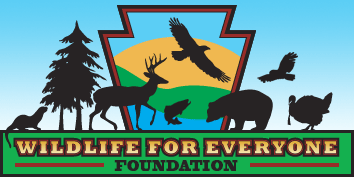Projects:
Soaring Eagle Wetland (formerly Governor Tom Ridge Wetland) and Julian Wetland - HISTORY
Wildlife For Everyone Foundation dedicated 135 acres along Route 220 between Julian and Martha Furnace as the Gov. Tom Ridge Wetlands Preserve. The site includes about 55 acres of wetlands created by The WHM Group; 15 acres of upland woodland; a quarter-mile of frontage on Bald Eagle Creek, which is a multi-use recreational stream stocked with trout; about 1.5 miles of trails along the wetlands; off-street parking; and 35-40 acres that could be developed by WFEEF in the future.
WHM, based in State College with offices in Harrisburg, Delaware Valley and Western Pennsylvania, acquired and developed the site beginning in 2002, under contract with the Department of Transportation, as wetlands mitigation for environmental disruption caused by the relocation of Interstate 99, and as a Federal Highway Administration demonstration site.
In accepting the honor, Gov. Ridge noted that The WHM Group "to advance the public good...designed and secured regulatory permits, constructed the wetlands, with its private sector expertise, including its scientists and environmentalist and constructionist engineers, to create the environmental credits necessary to offset similar functioning wetlands taken by I 99 construction...thus providing a private sector solution for the public sector…and further demonstrating the opportunity to secure credits in advance for those private and public organizations and companies pursuing construction in wetland areas." Ridge, who was governor of Pennsylvania from 1995-2001, explained, "When I was a young man I worked at Presque Isle State Park (at Erie) and there are a lot of wetlands up there. I've had this great privilege of understanding the value of wetlands, even as a young man. I've learned to appreciate the natural purification that wetlands provide. I've learned to appreciate the habitat. I've learned to appreciate the waterfowl. I've learned to appreciate all the wonderful ecological things associated with wetlands." He added, "then in government, you find that you're trying to build the state, you're trying to grow the economy and you're trying to take advantage of the potential that this great commonwealth has, and every once in a while, development clashes with the need to preserve Penns Woods. What you've got to do is figure out a way that you don't compromise either one. You've got to figure out a way that you can develop your state and still protect the beauty that is Penns Woods."
Ridge also recognized PennDOT for working with the private sector to balance needs.
Michael Schaul, President of The WHM Group, said, "The WHM science and business goal for the Bald Eagle project was to avoid any and all long-term mechanical support systems for the project, while creating a fully functioning ecosystem capable of sustaining a habitat to host the return of Pennsylvania's indigenous species as overseen by Mother Nature."
The site has attracted an increasingly diverse wildlife population, including species from aquatic mammals to birds to reptiles and amphibians.
Mal Gilbert, a WHM Senior Wetlands Scientist, said members of the State College Bird Club have reported that "several species of birds that haven't been recorded in the State College area for about five decades are now occurring down in these pools." Among those species are the Virginia rail, American bittern, moorhen, pied-billed grebe, the golden eagle, the bald eagle, and the Northern Harrier.
Janet Nyce, President of the WFEEF Board, described the wetlands as "a signature piece of property that can go on in perpetuity to teach the citizens from young to old about the jewels that are in this commonwealth."
As part of the contract with PennDOT, Schaul explained, the ultimate goal was to turn the site over to a non-profit organization that would act as steward of the property and the habitat into the future. "We looked at lot of different places for a non-profit to serve as a caretaker for the property, and there are a lot of good non-profits out there," Schaul explained. "But we settled on WFEEF because of its future view of things, of teaching kids the kinds of things that are necessary to continuing the stewardship of our wildlife and our environment."
The WHM Group also established for the Foundation a $50,000 maintenance account for the wetlands.
WFEEF Board Chairman Russ Schleiden said, "We're only 5-years-old, but people are noticing what we're doing."
WFEEF Executive Director Vern Ross, who worked with the former governor as Pennsylvania's first Governor's Sportsman Advisor and later at executive director of the Pennsylvania Game Commission, introduced Ridge at the dedication ceremony. Ross said, "he's a very special man. He was our governor. He's a friend to every one of us."
Among Ridge's conservation accomplishments while governor:
- The first governor to buy and use his own hunting and fishing licenses.
- Creation of the Governor's Sportsmen's Advisory Council and Youth Advisory Council.
- Signed the state's first elk hunting license in 73 years and the second spring gobbler tag.
- Participation in outdoor activities from turkey hunting to bear tagging to elk viewing.
- Supported the youth mentored hunting and Families Afield initiatives.
- Led the revitalization of the nearly defunct North American Hunting Symposium.
